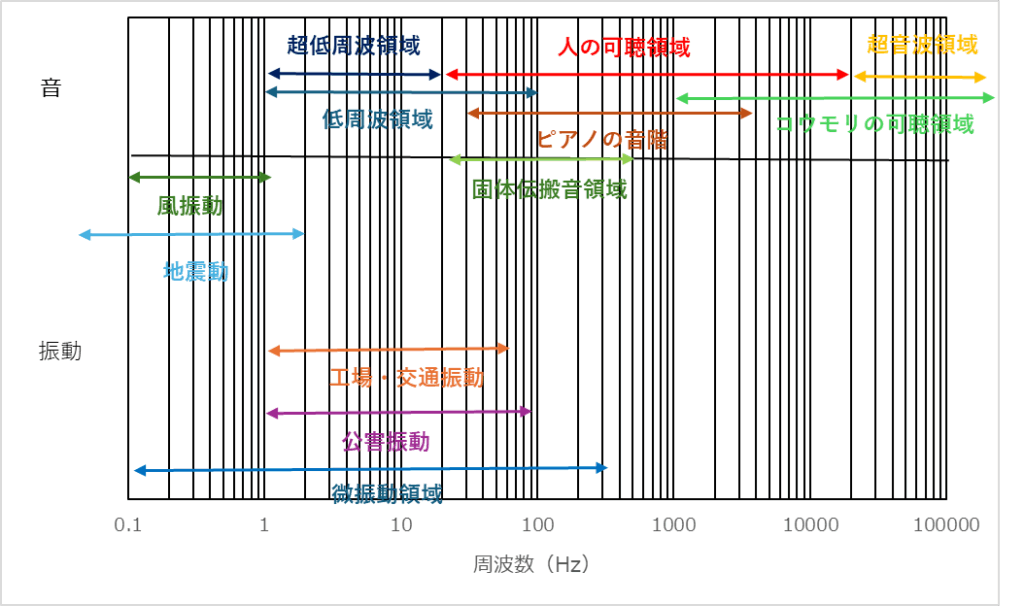Frequency is an essential term for understanding the invisible vibrations and sounds that exist all around us.
In this trivia, frequency is explained with typical examples of vibration and sound frequency ranges.
What is Frequency?
Frequency is the number of waves or vibrations repeated per second and is expressed in hertz (Hz).
For example, the frequency of a phenomenon that oscillates 50 times per second is 50 Hz.
In the architectural field, it plays an important role mainly in capturing the nature of sound and vibration.
The periodic nature of these sounds and vibrations is expressed by the index of frequency. Phenomena such as sound and vibration always have a "periodicity," and the frequency is determined by the length of this periodicity. The higher the frequency, the faster the vibration with a shorter period, and the lower the frequency, the slower the vibration.
There is a relationship f = 1/T between frequency f (Hz) and period T (seconds).
Typical sound and vibration frequency ranges are shown in Figure 1.
Refer to Figure 1 for a better understanding of the frequency domain characteristics and effects of each phenomenon.

supplement
(1) Low frequency sound area (very low frequency sound area)
Refers to sounds below 100 Hz.
Loud sounds are not only noisy, but can also cause fittings to shake and people to experience unpleasant symptoms such as headaches, insomnia, and dizziness. In addition, sounds below 20 Hz, a frequency normally inaudible to the human ear, are sometimes referred to as the very low frequency range.
(2) Human audible range area
Sounds between 20 Hz and 20,000 Hz are usually considered the range that people can hear. Some people may hear sounds at even lower or higher frequencies. All common noise problems refer to sounds in this region.
(3) Ultrasound field
Sounds above 20,000 Hz. Sound too high to be heard by normal people. No effect on humans.
(4) Solid propagating sound region
Refers to sound that is transmitted through a solid as vibration and radiated as sound by vibrating objects such as floors, walls, and ceilings.
In general, higher frequency vibrations are less easily converted to solid sound, with frequencies ranging from 20 Hz, the lower limit of the human audible range, to about 500 Hz, unless the vibration is very loud.
(5) Wind vibration
Wind vibration, which is handled by Environmental Vibration, refers to horizontal vibrations that occur on building floors when wind strikes a high-rise building. Generally, it covers a frequency range of about 0.1 Hz to 1.0 Hz*1.
(6) Seismic motion
Ground motion caused by earthquakes. It has a unique period depending on the ground. Typical spectra of recent earthquakes are in the 0.1 Hz to 10 Hz component*2.
(7) Plant and traffic vibration
Vibration frequencies vary depending on the type of train, car, or machine in operation, but in general, vibrations of frequencies between 1 Hz and 60 Hz*3 are the main types of vibration.
(8) Pollution and vibration
The frequencies considered problematic as pollution are 1 Hz to 90 Hz*4.
(9) Microvibration area
Although small vibrations are not a problem for humans, they are a problem for machines (precision instruments) such as electron microscopes, where even small vibrations can be problematic.
The VC standard for tolerance criteria for precision machinery is 1 to 80 Hz, but the frequency range varies in specifications for precision machinery.
References
1 Easy-to-understand knowledge of environmental vibration by Goto and Hamamoto
note 2 (supplementary information)Ministry of Land, Infrastructure, Transport and Tourism, Japan Meteorological Agency HP: Spectrum of seismic waves
3 Environmental White Paper, FY1947 edition, Ministry of the Environment
